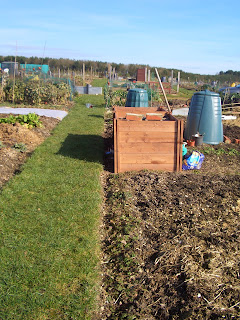
We are very lucky on our allotments to have an unlimited supply of horse and cow manure brought to the site by local farmers. This may be either straw or wood shavings based, and may be supplied in various stages of decomposition. We have just had the latest load delivered and as I gradually clear the crops, I am busy stockpiling barrow loads onto the bare earth ready to be spread and dug or forked in over the autumn and winter. A thick layer over the soil at this stage will keep any weeds at bay, and once dug in it also really helps to break up the heavy clay soil, improving its texture and drainage, as well as supplying plenty of nitrogen for healthy crops next year.
I also compost all plant waste on the site. Here you can see my two green plastic bins, and the two wooden compost containers, that are filled in rotation. By the time the fourth container is filled to the brim the first container will have produced beautiful sweet smelling, fully rotted compost, that will be fine and friable to the touch and can be spread across the allotment.
The plastic "dalek" bins are OK, but the very best compost is being made in the two square wooden bins. I bought them from The Recycle Works, they are very easy to construct from the flat packed wood, and I am delighted with the first compost from them.
Like many other "plotters" I started with a compost bin made from old wooden pallets, tied together with string at the corners - very rough and ready! These seem to be very popular - presumably because they are cheap - but they do not make good compost; there is too much ventilation, the material dries out too readily and does not heat up sufficiently to complete the decomposition process.
No comments:
Post a Comment